Poverty and Income Inequality in Scotland 2012/13
Annual estimates of the percentage and number of people, children, working age adults and pensioners living in low income households in Scotland in 2012/13.
This document is part of a collection
Chapter 2: Income Inequality and the distribution of income
2.1 Income distribution
Key points:
- In 2012/13, the percentage of income received by households in the bottom 3 deciles was 14 per cent, unchanged from previous years.
- There has been very little change in income inequality since 1998/99.
This section provides information that relates to the Scottish Government's Solidarity Purpose Target which is "to increase overall income and the proportion of income earned by the three lowest income deciles as a group by 2017". More information can be found at the following link:
http://www.scotland.gov.uk/About/Performance/scotPerforms/purpose/solidarity
Chart 6 shows the percentage of total income received by the three lowest income deciles (the thirty per cent of the population with the lowest incomes), from 1998/99 to 2012/13. It also shows the percentage of total income received by the three highest income deciles. This is a measure of how equally income is distributed across the population.
Chart 6 - Percentage of income going to the bottom and top three deciles
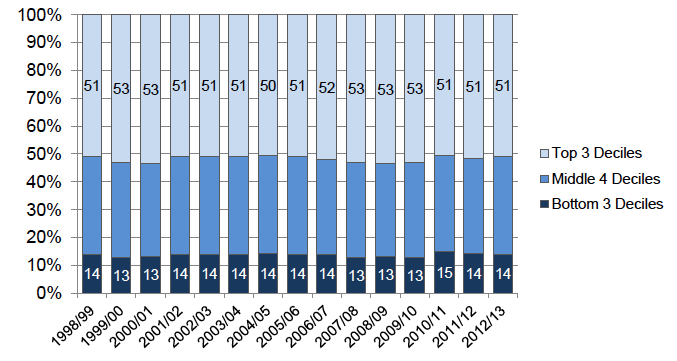
Source: HBAI dataset, DWP.
Commentary:
In 2012/13, the percentage of income received by households in the bottom 3 deciles was 14 per cent, unchanged from previous years.
Having dropped from 54 per cent to 51 per cent between 2009/10 and 2010/11, the percentage of income received by households in the top three income deciles has remained unchanged since then.
There has been no significant change in income inequality between 2011/12 and 2012/13 using this measure. Over the longer term it can be seen that there has been very little change in income inequality since 1998/99, with the percentage of income received by the bottom 3 deciles remaining at between 13 and 14 per cent.
Deciles / decile points:
Deciles (or decile points) are the income values which divide the Scotland population, when ranked by income, into ten equal-sized groups. Therefore nine decile points are needed in order to form the ten groups. Decile is also often used as a shorthand term for decile group; for example 'the bottom decile' is used to describe the bottom ten per cent of the income distribution.
Decile groups:
These are groups of the population defined by the decile points. The lowest decile group is the ten per cent of the population with the lowest incomes. The second decile group contains individuals with incomes above the lowest decile point but below the second decile point.
2.2 Income thresholds
Key points:
- In 2012/13, median household income in Scotland was £23,000, a decrease of £400 per year compared with 2011/12.
- The relative poverty (BHC) threshold in 2012/13 was £13,800, equivalent to £264 a week for a couple with no children. This is unchanged from 2011/12. Changes in relative poverty therefore reflect genuine changes in income and are not due to changes in median income.
- A couple with no children with a combined income of over £35,200 (after tax and benefits) would be in the highest income 20 per cent of the population.
Note: In this publication, all statistics are based on net income. That is, income after taxes and including benefits. Income is calculated at the household level, and reflects the income available to the household after taxes are paid and all benefits and tax credits have been received.
Most of the income figures in this publication are based on equivalised income. One consequence of the equivalisation process is that there are different poverty thresholds for households of different sizes and compositions. To help readers understand the figures in this publication, Table 1 below presents some commonly used income thresholds, before equivalisation, for households of different sizes. The incomes presented elsewhere in this report use the value for "Couple with no children" as the standard, and all other household types are adjusted to reflect their different household composition.
Table 1 - Income thresholds (£) for different household types (income after tax and BHC)
| Single person with no children |
Couple with no children |
Single person with children aged |
Couple with children aged 5 and 14 |
|||||
|---|---|---|---|---|---|---|---|---|
| weekly |
annual |
weekly |
annual |
weekly |
annual |
weekly |
annual |
|
| UK median income (before housing costs) |
295 |
15,400 |
440 |
22,900 |
528 |
27,500 |
673 |
35,100 |
| Scottish median income (before housing costs) |
295 |
15,400 |
440 |
23,000 |
529 |
27,600 |
674 |
35,100 |
| 60% of UK median income (before housing costs) - relative poverty threshold |
177 |
9,200 |
264 |
13,800 |
317 |
16,500 |
404 |
21,000 |
| 60% of inflation adjusted 2010/11 UK median income (before housing costs) - absolute poverty threshold |
182 |
9,500 |
272 |
14,200 |
326 |
17,000 |
416 |
21,700 |
| Scottish 1st income decile |
148 |
7,700 |
221 |
11,500 |
265 |
13,800 |
338 |
17,600 |
| Scottish 2nd income decile |
191 |
9,900 |
285 |
14,800 |
342 |
17,800 |
436 |
22,700 |
| Scottish 3rd income decile |
224 |
11,700 |
334 |
17,400 |
401 |
20,900 |
511 |
26,600 |
| Scottish 4th income decile |
259 |
13,500 |
387 |
20,200 |
465 |
24,200 |
592 |
30,900 |
| Scottish 5th income decile |
295 |
15,400 |
440 |
23,000 |
529 |
27,600 |
674 |
35,100 |
| Scottish 6th income decile |
332 |
17,300 |
496 |
25,900 |
595 |
31,000 |
759 |
39,600 |
| Scottish 7th income decile |
382 |
19,900 |
570 |
29,700 |
684 |
35,700 |
873 |
45,500 |
| Scottish 8th income decile |
453 |
23,600 |
676 |
35,200 |
811 |
42,300 |
1034 |
53,900 |
| Scottish 9th income decile |
569 |
29,700 |
849 |
44,300 |
1019 |
53,100 |
1299 |
67,800 |
Source: HBAI dataset, DWP.
Note: to create ten decile groups only nine decile points are needed to split the population.
2.3 Trends in income distributions
Key points:
- In 2012/13, median income was £440 per week, a decrease of £9 on the previous year. This is the third consecutive year median income in Scotland has fallen.
- The bottom two deciles saw the largest income decreases compared with the previous year.
- Only the top two deciles saw an increase in income in 2012/13. Households at all other income deciles saw decreases in income in 2012/13.
Chart 7 shows how the median equivalised household income (BHC) in Scotland has changed from 1998/99 to 2011/12.
Chart 7 - Median weekly household income in Scotland (in 2012/13 prices)
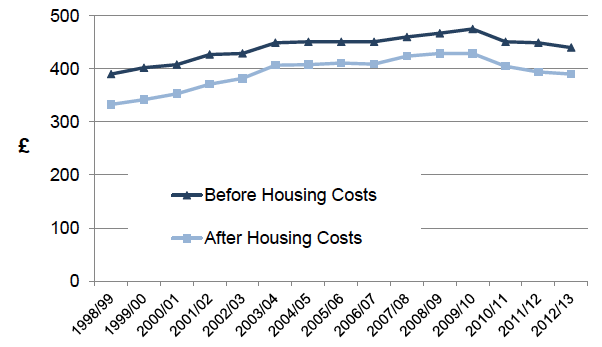
Source: HBAI dataset, DWP. These figures are also presented in Annex 1 (Table A6).
Charts 8A and 8B show median weekly household income, before housing costs and after housing costs, for households with children, working age adults, and pensioners.
Chart 8A - Median weekly household income (BHC) in Scotland (in 2012/13 prices)
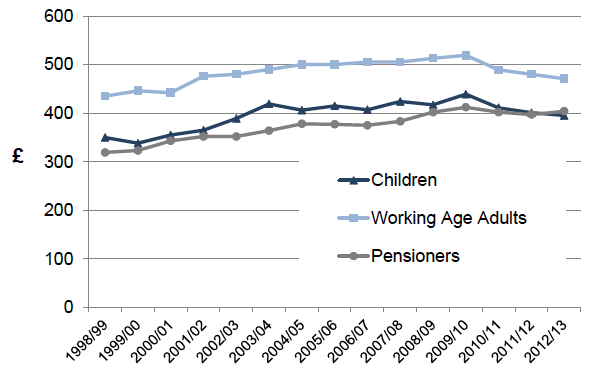
Chart 8B - Median weekly household income (AHC) in Scotland (in 2012/13 prices)
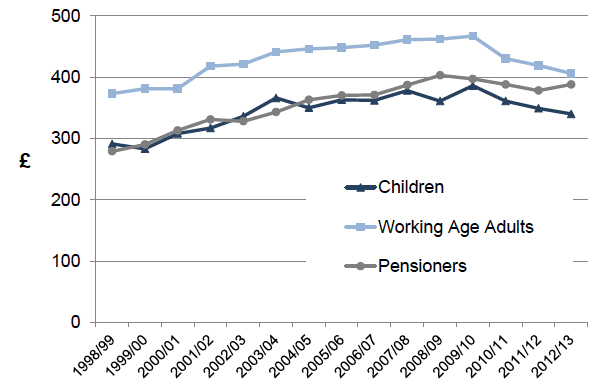
Source: HBAI dataset, DWP. These figures are also presented in Annex 1 (Table A7).
In 2012/13, median household income was £440 per week, a decrease of £9 compared with 2011/12. This is the third consecutive year median income in Scotland has fallen, and median income in 2012/13 is at the lowest level since 2002/03. All incomes are quoted in 2012/13 prices.
Commentary:
There was a gradual increase in median equivalised weekly household income (BHC) in Scotland from £390 in 1998/99 to £475 in 2009/10 followed by a fall to £451 in 2010/11. Median income in 2011/12 fell slightly to £449 per week. Median income then fell to £440 in 2012/13, the third consecutive annual fall in median income in Scotland.
The pattern is similar for median equivalised weekly household income (AHC) in Scotland, which was £333 in 1998/99 increasing to £429 in 2009/10, followed by a fall to £405 in 2010/11 and £394 in 2011/12. Median income AHC continued to drop in 2012/13 to £390, again the lowest level since 2002/03.
Chart 9 shows how the weekly equivalised incomes have changed from 2008/09 to 2012/13 across the different income decile points. Decile points are the incomes that separate out the 10 deciles, so 10 per cent of the population have household income below the 1st decile point and 90 per cent of the population have income below the 9th decile point.
Chart 9 - Weekly household incomes for each decile point from 2008/09 to 20012/13
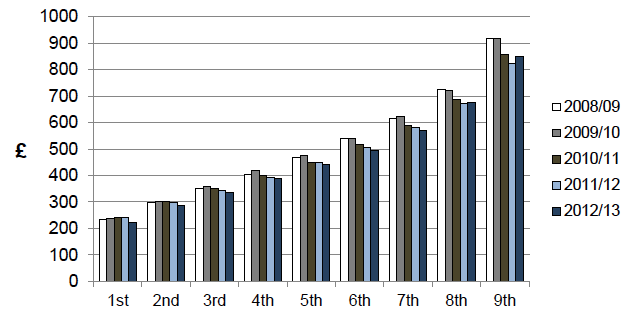
Source: HBAI dataset, DWP. These figures are also presented in Annex 1 (Table A8).
Chart 10 shows the percentage change in each income decile point in 2012/13 compared to 2011/12.
Chart 10 - Percentage change in each decile point between 2011/12 and 2012/13 (In real prices)
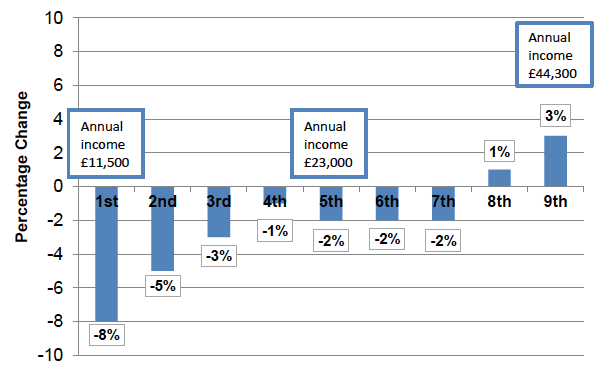
Source: HBAI dataset, DWP.
Between 2008/09 and 2009/10, equivalised weekly household income in Scotland increased in real terms across all the income decile points except the 8th. In 2010/11, there was a drop in equivalised weekly household income at all but the bottom two income decile points. This is linked to the drop in average earnings. All deciles saw a decrease in 2011/12, in particular the top 4 deciles and deciles 3 and 4.
For households at the lowest two income decile points, income has fallen for the last two years. In 2012/13, the largest percentage decreases in household income was for those at the bottom income decile, with the second largest decrease for those at the second income decile.
For households at income deciles 3 to 7, 2012/13 is the third consecutive year of falls in household income. In 2012/13, while income fell for this group, the percentage decrease was less than for those on the lowest incomes.
Households at income deciles 8 and 9 (the top twenty per cent) saw small increases in income in 2012/13, following decreases in the previous two years.
Chart 11 below shows the distribution of weekly income across Scotland in 2012/13. The shaded area shows the shape of the 2012/13 income distribution and the black lines show the Scottish median income (£440) and the relative poverty threshold (BHC) (£264). The dark blue line superimposed shows the 2011/12 income distribution for comparison.
Chart 11 - Distribution of weekly household income with Scottish median and relative poverty threshold (BHC)
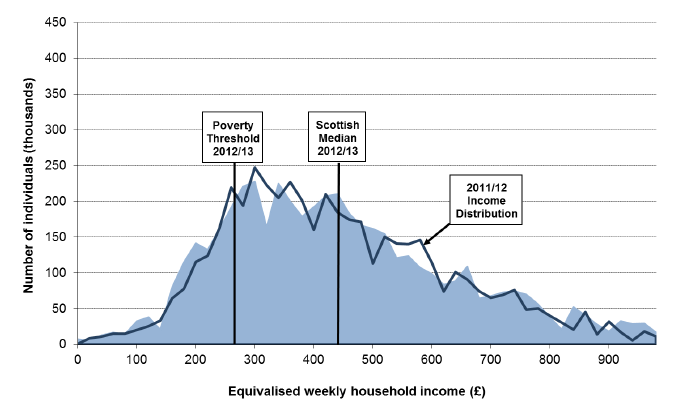
Source: HBAI dataset, DWP.
Chart 12 shows the same distribution with income deciles for Scotland marked with black lines.
Chart 12 - Distribution of weekly household income with income decile points
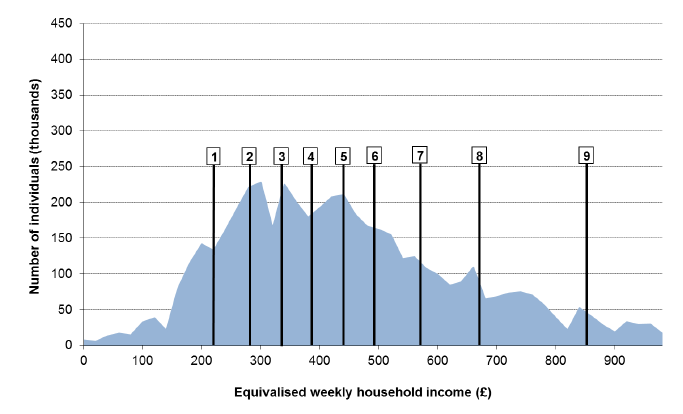
Source: HBAI dataset, DWP.
The relative poverty threshold is based on the UK median equivalised household income. As the UK median income fell in 2011/12, the poverty threshold also fell in 2011/12. In 2012/13, the UK median remained unchanged, as did the poverty threshold. Median income in Scotland was higher than the UK median in 2011/12 but in 2012/13, it had dropped to the same level (£440). In 2012/13 the poverty threshold was therefore £264 per week (for a couple with no children).
Contact
Email: Stephen Smith
There is a problem
Thanks for your feedback